Introduction to Astronomy
The H-R Diagram
A Hertzsprung-Russell (H-R) diagram is constructed by looking at lots of stars, and finding their spectral and luminosity classes. Then plot the luminosity class on the y-axis, and the spectral class on the x-axis. You get something that looks like this:

This diagram is the most important diagram in all of astronomy. It shows you, all in one picture, the lifetime of a star.
Stellar Evolution
Let's overview of stellar evolution, just so that we see where we're going, and how it all fits together:
- Stars are 'born': Stars form out of clouds of dust and gas. This takes about 10 million years.
- Stars 'live': Then, once hydrogen-burning begins in the core, the star enters the Main Sequence phase of it's lifetime, which is by far the longest portion of the observable star's life. The length of time a star remains on the Main Sequence depends on the mass. High mass stars have shorter Main Sequence lifetimes. This is because when the mass is higher, the pressures and temperatures inside the star are higher, and the hydrogen burns faster. This is sort of like the difference between cooking food under high pressure (in a pressure cooker, or at sea level), and cooking under low pressure (at altitude, say). Stuff at higher pressure cooks faster.
For reference, the Sun's Main Sequence lifetime is estimated to be 10 billion years. Approximately 4.5 billion of those have already passed. A star 10 times as massive as the Sun has a Main Sequence lifetime of only 30 million years (dinosaurs roamed the Earth 60 million years ago). A star 0.1 times as massive as the Sun has a lifetime of 3 trillion years.
Naturally, you can express this relationship mathematically, if you like:
(t/tsun)=(M/Msun)-2.5
where t is the main sequence lifetime, M is the mass of the star, and sun indicates those values for the sun.
- Stars 'die': After the Main Sequence, stars can evolve in one of two ways: either they lose their envelope slowly, and become planetary nebulae plus white dwarfs, or they lose it quickly, in a supernova explosion, and leave behind a core that is either a neutron star or a black hole.
Well. We'd better look at this in a little more detail!
 Star and Planet Formation (Stars are born.)
Stars form in Giant Molecular Clouds. Giant means GIANT, even by astronomical standards. A typical GMC is 10 pc (parsecs) across. (Recall that 1 pc=206,265 AU=3.26 light years!), and contains the mass of one million suns. There are thousands of these in our galaxy. The Orion Nebula is the nearest GMC to us, and is at a distance of ~450 pc.
Star and Planet Formation (Stars are born.)
Stars form in Giant Molecular Clouds. Giant means GIANT, even by astronomical standards. A typical GMC is 10 pc (parsecs) across. (Recall that 1 pc=206,265 AU=3.26 light years!), and contains the mass of one million suns. There are thousands of these in our galaxy. The Orion Nebula is the nearest GMC to us, and is at a distance of ~450 pc.
 The Eagle Nebula is also currently forming stars. For scale, the tall pillar in this picture is 16 TRILLION miles high.
The Eagle Nebula is also currently forming stars. For scale, the tall pillar in this picture is 16 TRILLION miles high.
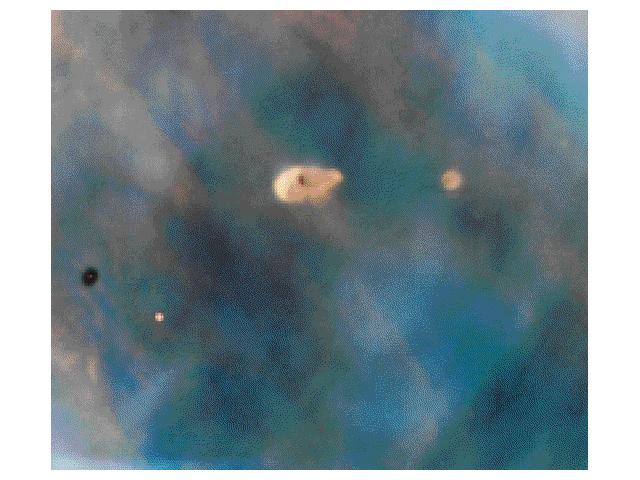 GMC's are clumpy. This close-up view shows some clumps. The clumps are called globules, and if a star will form, it will form from one of these globules.
GMC's are clumpy. This close-up view shows some clumps. The clumps are called globules, and if a star will form, it will form from one of these globules.
How do we know that clumps are the regions of star formation?
- Lots of IR radiation: This IR radiation is the product of heated dust, in this case, heated by losing gravitational potential energy. Think about a ball rolling down a hill. This ball gets more energy of motion as it gives up its gravitational energy. The same thing happens to the dust and gas in a nebula as it shrinks. The atoms and molecules move faster and faster, which is the same as saying they get hotter and hotter (a few hundred Kelvin). Remember that objects that are a few hundred Kelvin emit lots of IR light. So. We have collapsing clouds that are big and warm => stars could form there.
- Young stars nearby: We often see young stars near clumps in a GMC.
- Actual pictures! We have improved our imaging abilities so much that we can get actual pictures of stars forming. Most of the baby stars that we can take pictures of are at the edge of a GMC, and exposed only because of winds from other stars. The picture of globules above is one example of this.
What causes globules?
We don't really know, but two of the theories on the table are:
- Gas Ejection: A supernova somewhere near the GMC (or perhaps inside of it) explodes, and material ejected from it sweeps up dust and gas in the GMC, causing a globule. My own personal opinion is that this theory has "chicken and egg" problems. Sometime, there must have been a first clump to start a star that would become a supernova, and begin the whole process of evolving the Universe to the state in which we see it today. But what started that clump?
- Turbulence: Suppose that the dust and gas is randomly distributed in the GMC. Randomness means that sometimes it's going to be smoothly distributed, and sometimes it's going to be clumpy. This is a sort of chaos theory explanation, that I personally favor. I suspect that in the end, we will find that both theories are playing a role in the Universe today, but in the beginning, only turbulence was operating.
What slows the collapse of the clump?
No one is surprised to find that clumps contract, or that they can make stars. What is surprising is that it happens so slowly. If you just take a cloud of dust and gas, and start gravity, then in about 100,000 years or so, the whole thing collapses, and you have a star. But the observed time frame is more like 1-10 million years. (We observe this from the number of stars in the galaxy. If it only took 100,000 years for a star to be born, there should be lots more of them---particularly young ones.)
To figure this out, we have to talk a bit about magnetic fields. There is a magnetic field that runs through the galaxy, similar to the one that runs through the solar system, or is in place around our planet, or is caused by a magnet. It is a rule of physics that charged particles can't cross magnetic field lines. If they try, they get caught by the field, and wind up circling the magnetic field line.
So. Here is a cloud of dust and gas, with magnetic field lines running through it. All of the mass wants to go to the middle because of gravity, but the chargit. All of the mass wants to go to the middle because of gravity, but the charged particles can't cross the lines, so they remain stationary. The neutral particles can cross the lines, but only if they can get past the charged particles. It's like a giant game of "Red Rover". Occasionally the neutral particles get through the line, and make it to the center of the dust cloud. After a while (1- 10 million years), there is so much mass in the center that the gravitational force overcomes the drag of the charged particles, and the neutrals begin pouring across the magnetic field lines. (Imagine Red Rover so that the people who've made it through can pull on ropes attached to their team-mates to help them get through. Eventually, there will be so many people who've crossed the line that the line will be helpless against the "Rover" trying to get across.) Once this happens, mass will gather rapidly, and a star will form in roughly 100,000 years.
Protostars: A protostar is a clump that is on its way to forming a star, but hasn't quite gotten there yet. The time period that we are talking about here is the time period from shortly before the gravity overcomes the magnetic field to the time that the star ignites. If we look more closely at this time period, we see that several things happen.
- Material falls onto the protostar: This seems pretty obvious, but is important for several reasons. The first is that as the material falls onto the star, the star becomes denser and thus more opaque. This means that redder photons have a harder time leaving the star. The more opaque the star, the higher the energy light must have to get out.
- A disk forms because of conservation of angular momentum, and is dispersed by one of the following mechanisms:
- Evaporation by a nearby hot, bright star.
- Wind dispersal: Via the wind from the central star
- Planet Formation: We will soon know all about this!
- Temperature and pressure increase: Since the protostar is now opaque, it can no longer radiate away the energy produced by the infalling material. This energy is trapped inside the protostar, and causes the temperature to rise. Also, as the mass falls inward, the pressure increases until the pressure inside pushing out equals the gravitational force inwards. This slows, but does not stop the collapse (see next bullet).
-
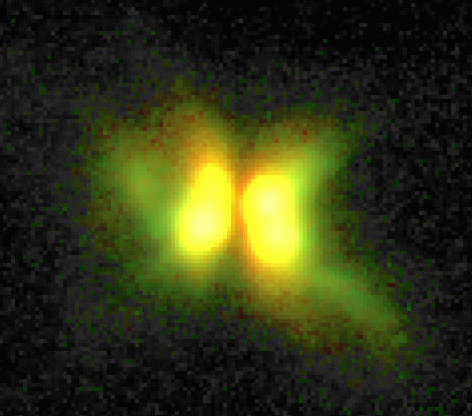 A wind develops: We're not quite sure why, but at this stage in the evolution, the protostar begins pushing mass away. This stops the infall of more mass. The inner part of the protostar continues to collapse to balance the radiation of energy from the surface. (This is called Kelvin-Helmholtz contraction.) These winds are enormous: 10-7 solar masses per year. In other words, if the sun were losing mass this quickly, it would lose all of its mass in only (!) 10 million years---an astronomically short time period! At right is a picture of a young stellar object blowing off mass.
A wind develops: We're not quite sure why, but at this stage in the evolution, the protostar begins pushing mass away. This stops the infall of more mass. The inner part of the protostar continues to collapse to balance the radiation of energy from the surface. (This is called Kelvin-Helmholtz contraction.) These winds are enormous: 10-7 solar masses per year. In other words, if the sun were losing mass this quickly, it would lose all of its mass in only (!) 10 million years---an astronomically short time period! At right is a picture of a young stellar object blowing off mass.
- P, T increase some more: Still the pressure and the temperature are rising in the central portion of the protostar. Eventually, they become high enough to "ignite" the hydrogen fusion process, and the protostar moves onto the Main Sequence, and is finally a star!
Planet Formation
Disk Formation:
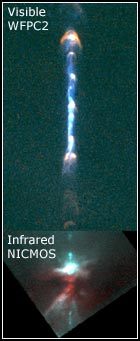 As stars form, the dust and gas collapses from a large cloud to a small cloud. During this collapse, it must conserve lots of physical quantities, like mass, energy, and angular momentum. Mass and energy are pretty straightforward to understand, but angular momentum requires a little explanation. The angular momentum of an object describes its rotation. Fast rotators have large angular momentum. Large objects also have large angular momentum. So do massive ones (massive is not necessarily the same as large!). This angular momentum is a conserved quantity. That means that if you have a large object, and you make it small, it has to rotate faster, so that angular momentum is conserved (think of an ice skater pulling in her arms). But transferring angular momentum around a cloud is difficult. Every little particle has to interact with another one before it can give up angular momentum. This means that if you start out with a rotating cloud, it will collapse really fast down the axis to the 'equator', since there's no angular momentum in that direction. But it will collapse really slowly in towards the axis. The whole thing flattens out, and you get a disk which is much denser than the cloud you started with (you've put all that mass in a smaller space).
As stars form, the dust and gas collapses from a large cloud to a small cloud. During this collapse, it must conserve lots of physical quantities, like mass, energy, and angular momentum. Mass and energy are pretty straightforward to understand, but angular momentum requires a little explanation. The angular momentum of an object describes its rotation. Fast rotators have large angular momentum. Large objects also have large angular momentum. So do massive ones (massive is not necessarily the same as large!). This angular momentum is a conserved quantity. That means that if you have a large object, and you make it small, it has to rotate faster, so that angular momentum is conserved (think of an ice skater pulling in her arms). But transferring angular momentum around a cloud is difficult. Every little particle has to interact with another one before it can give up angular momentum. This means that if you start out with a rotating cloud, it will collapse really fast down the axis to the 'equator', since there's no angular momentum in that direction. But it will collapse really slowly in towards the axis. The whole thing flattens out, and you get a disk which is much denser than the cloud you started with (you've put all that mass in a smaller space).
In the picture at right, you can see the disk as the dark-red part in the lower image. You can also see WAY COOL jets coming out of the forming star (we have, frankly, NO IDEA, why this happens---but it's still way cool!)
Here're some more jets, just because they are nifty.
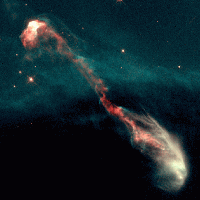
Planetesimal Formation:
In this dense cloud, you have lots of opportunity for dust to run into other dust, and stick together, making little interstellar dust bunnies. No, really, that's pretty much what happens! They are light and fluffy, and mis-shapen, just like the dust bunnies under your bed. Now, you have big particles, which make larger targets for more dust to collect. Eventually, these dust bunnies grow to be 100 m across (that's more than 300 ft!). They no longer would fit under your bed. In the process, these dust bunnies have gotten more massive, and more dense, so they now are more like the dust bunnies after you've swept them up with a broom and packed them into the dust pan. You could still pull them apart pretty easily.
These larger particles continue to run into other particles until they reach about a kilometer in size. At this point, they are massive enough that they actually begin to interact with each other not just by being in the way (like cars on the highway), but also by gravity. At this size, we call them 'planetesimals', which means 'tiny planets'.
Planet Formation:
Now, these gravitationally attracted planetesimals begin to crash into each other more frequently, sticking together, and growing over a long period of time to become planets!
Jovian vs. Terrestrial Planets:
Jupiter is fundamentally an enormous ball of gas, and the Earth is fundamentally a ball of rock. Why are they so different?
When the disk formed, the material that came all the way in to 1 AU (where the Earth is), got much hotter than material that came only as far as Jupiter. Why? Because it 'fell' down a longer hill, and therefore turned more gravitational potential energy into heat energy. More energy means hotter. So the inner solar system was hot, and the outer solar system was cool. So only materials that remain solid at high temperatures (i.e. stuff in rocks---iron, silicates, carbon, etc.) survived in the dust in the inner solar system. The rest remained in gas form until the solar wind began and blew them out to the outer solar system. In the outer solar system, however, rock stuff AND ices (like water, carbon dioxide, methane, etc.) could stay in solid form long enough to be gathered up by the large planetesimals that formed the gas giant planets. So the giant planets have much different composition that the Earth---not because rocks are missing, but because ices were added.
This theory of planet formation is brilliant. It hangs together beautifully, is simple (relatively speaking), and describes the solar system flawlessly. Hooray for science.
And then...in 1995...
The first extra-solar planet (a planet around another star) was discovered. Drat. Why drat? Because it was a REALLY BIG planet REALLY CLOSE to its central star. Astronomers: back to work! In the last few years, astronomers have been struggling to add in this new data. We now know of over 80 planets around other stars, and not one of these systems looks like our own. All of them are REALLY BIG planets REALLY CLOSE to their central star. If you go to The Extrasolar Planets Encyclopedia, you can see information about all of them, and have fun making bar charts (histograms) and graphs (correlations) of all their different properties. No really. It's fun! Try it!
One thing you can do is plot the mass vs distance from the central star.
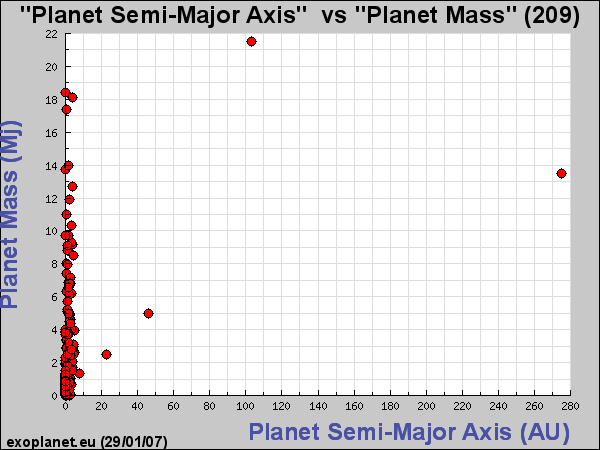 If we 'stretch' the x-axis, so we aren't distracted by those three really distant ones, we see this:
If we 'stretch' the x-axis, so we aren't distracted by those three really distant ones, we see this:
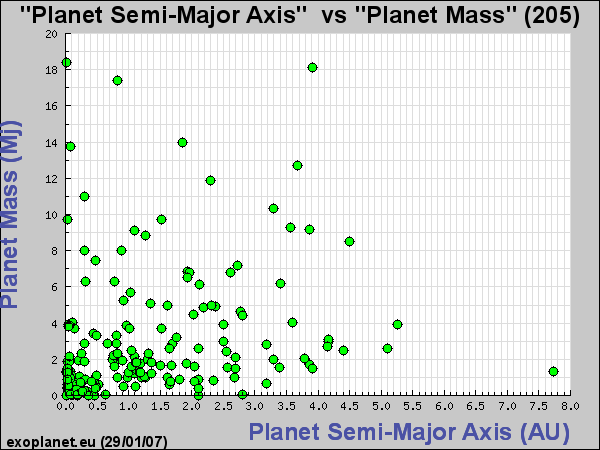 So, you can see that most planets are really big, and really close. Nothing at all like our own solar system. Hooray! More work to do!
This has led to the development of a 'plug-in' for standard planet formation theory. In this plug in, the disk sticks around long enough to steal energy from the orbits of some of the planets. This causes them to move in towards the central star. Over time, these planets may interact with other planets, kicking them in towards the star, or out of the system all together. This 'planet migration' theory describes very well what has been observed so far. Even now, astronomers are looking for lonely planets in space that might have been kicked out from their system early in the development. If they are found, it will help to clinch the new model.
So, you can see that most planets are really big, and really close. Nothing at all like our own solar system. Hooray! More work to do!
This has led to the development of a 'plug-in' for standard planet formation theory. In this plug in, the disk sticks around long enough to steal energy from the orbits of some of the planets. This causes them to move in towards the central star. Over time, these planets may interact with other planets, kicking them in towards the star, or out of the system all together. This 'planet migration' theory describes very well what has been observed so far. Even now, astronomers are looking for lonely planets in space that might have been kicked out from their system early in the development. If they are found, it will help to clinch the new model.
Concept Question 1:
Which of the following pairs of quantities can be plotted against each other to produce an H-R diagram?
- Temperature and distance
- Temperature and spectral class
- Luminosity and spectral class
- Luminosity and distance
Concept Question 2:
Where do most stars lie on the H-R diagram?
- White dwarf region
- Supergiant region
- Giant region
- Main sequence
Concept Question 3:
Why do most stars in the H-R diagram lie on the main sequence?
- There are more main sequence stars than ever before.
- Other stars are more difficult to see.
- Other stars are farther away.
- The main sequence is the longest part of a star's life.
Concept Question 4:
Rigel is _______ than Antares
- hotter and bluer
- cooler and redder
- cooler and bluer
- hotter and redder
Concept Question 5:
If magnetic fields were NOT important to star formation, how would the Galaxy be different?
- There'd be lots more stars.
- There'd be lots more dust.
- There'd be fewer stars.
- There'd be lots more planets.

















 Star and Planet Formation (Stars are born.)
Stars form in Giant Molecular Clouds. Giant means GIANT, even by astronomical standards. A typical GMC is 10 pc (parsecs) across. (Recall that 1 pc=206,265 AU=3.26 light years!), and contains the mass of one million suns. There are thousands of these in our galaxy. The Orion Nebula is the nearest GMC to us, and is at a distance of ~450 pc.
Star and Planet Formation (Stars are born.)
Stars form in Giant Molecular Clouds. Giant means GIANT, even by astronomical standards. A typical GMC is 10 pc (parsecs) across. (Recall that 1 pc=206,265 AU=3.26 light years!), and contains the mass of one million suns. There are thousands of these in our galaxy. The Orion Nebula is the nearest GMC to us, and is at a distance of ~450 pc.
 The Eagle Nebula is also currently forming stars. For scale, the tall pillar in this picture is 16 TRILLION miles high.
The Eagle Nebula is also currently forming stars. For scale, the tall pillar in this picture is 16 TRILLION miles high.
 GMC's are clumpy. This close-up view shows some clumps. The clumps are called globules, and if a star will form, it will form from one of these globules.
GMC's are clumpy. This close-up view shows some clumps. The clumps are called globules, and if a star will form, it will form from one of these globules.
 A wind develops: We're not quite sure why, but at this stage in the evolution, the protostar begins pushing mass away. This stops the infall of more mass. The inner part of the protostar continues to collapse to balance the radiation of energy from the surface. (This is called Kelvin-Helmholtz contraction.) These winds are enormous: 10-7 solar masses per year. In other words, if the sun were losing mass this quickly, it would lose all of its mass in only (!) 10 million years---an astronomically short time period! At right is a picture of a young stellar object blowing off mass.
A wind develops: We're not quite sure why, but at this stage in the evolution, the protostar begins pushing mass away. This stops the infall of more mass. The inner part of the protostar continues to collapse to balance the radiation of energy from the surface. (This is called Kelvin-Helmholtz contraction.) These winds are enormous: 10-7 solar masses per year. In other words, if the sun were losing mass this quickly, it would lose all of its mass in only (!) 10 million years---an astronomically short time period! At right is a picture of a young stellar object blowing off mass. As stars form, the dust and gas collapses from a large cloud to a small cloud. During this collapse, it must conserve lots of physical quantities, like mass, energy, and angular momentum. Mass and energy are pretty straightforward to understand, but angular momentum requires a little explanation. The angular momentum of an object describes its rotation. Fast rotators have large angular momentum. Large objects also have large angular momentum. So do massive ones (massive is not necessarily the same as large!). This angular momentum is a conserved quantity. That means that if you have a large object, and you make it small, it has to rotate faster, so that angular momentum is conserved (think of an ice skater pulling in her arms). But transferring angular momentum around a cloud is difficult. Every little particle has to interact with another one before it can give up angular momentum. This means that if you start out with a rotating cloud, it will collapse really fast down the axis to the 'equator', since there's no angular momentum in that direction. But it will collapse really slowly in towards the axis. The whole thing flattens out, and you get a disk which is much denser than the cloud you started with (you've put all that mass in a smaller space).
As stars form, the dust and gas collapses from a large cloud to a small cloud. During this collapse, it must conserve lots of physical quantities, like mass, energy, and angular momentum. Mass and energy are pretty straightforward to understand, but angular momentum requires a little explanation. The angular momentum of an object describes its rotation. Fast rotators have large angular momentum. Large objects also have large angular momentum. So do massive ones (massive is not necessarily the same as large!). This angular momentum is a conserved quantity. That means that if you have a large object, and you make it small, it has to rotate faster, so that angular momentum is conserved (think of an ice skater pulling in her arms). But transferring angular momentum around a cloud is difficult. Every little particle has to interact with another one before it can give up angular momentum. This means that if you start out with a rotating cloud, it will collapse really fast down the axis to the 'equator', since there's no angular momentum in that direction. But it will collapse really slowly in towards the axis. The whole thing flattens out, and you get a disk which is much denser than the cloud you started with (you've put all that mass in a smaller space).

 If we 'stretch' the x-axis, so we aren't distracted by those three really distant ones, we see this:
If we 'stretch' the x-axis, so we aren't distracted by those three really distant ones, we see this:
 So, you can see that most planets are really big, and really close. Nothing at all like our own solar system. Hooray! More work to do!
This has led to the development of a 'plug-in' for standard planet formation theory. In this plug in, the disk sticks around long enough to steal energy from the orbits of some of the planets. This causes them to move in towards the central star. Over time, these planets may interact with other planets, kicking them in towards the star, or out of the system all together. This 'planet migration' theory describes very well what has been observed so far. Even now, astronomers are looking for lonely planets in space that might have been kicked out from their system early in the development. If they are found, it will help to clinch the new model.
So, you can see that most planets are really big, and really close. Nothing at all like our own solar system. Hooray! More work to do!
This has led to the development of a 'plug-in' for standard planet formation theory. In this plug in, the disk sticks around long enough to steal energy from the orbits of some of the planets. This causes them to move in towards the central star. Over time, these planets may interact with other planets, kicking them in towards the star, or out of the system all together. This 'planet migration' theory describes very well what has been observed so far. Even now, astronomers are looking for lonely planets in space that might have been kicked out from their system early in the development. If they are found, it will help to clinch the new model.